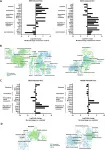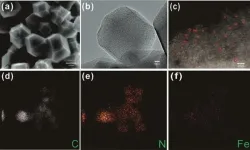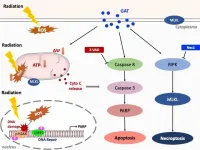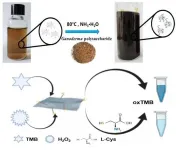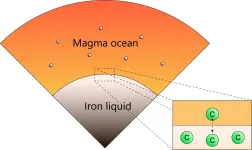Getting stoned: Revealing the mysteries of stonefish venom
2021-06-01
(Press-News.org) University of Queensland scientists working to unlock the mysteries Australia's deadly stonefish have made a discovery which could change how sting victims are treated in the future.
Stonefish are the most venomous fish in world and are found throughout shallow coastal waters of the northern half of Australia.
Study co-author Associate Professor Bryan Fry said previous studies have not been able to uncover all of the mechanisms at play in stonefish venom because of the way the venom was tested.
"There's a couple of reasons previous studies haven't been able to thoroughly decipher the toxicological mysteries of stonefish venom," Dr Fry said.
"But we've discovered a big one - labs were previously analysing only freeze-dried venom, as the venom is often dried in order to make it more stable for transportation and storage.
"By testing freshly milked venom our analysis revealed that the process of freeze-drying destroys paralytic neurotoxic activity of the sample, a key activity we're observing.
"Any lab studies using freeze dried venom therefore wouldn't recover all of the paralytic activity or some other functional activities of the venom, which is important, since stonefish antivenom is made using freeze dried venom.
"This means there's a possibility that current antivenom may not fully neutralise the paralytic effects in human stonefish envenomation, but this definitely needs more study.
"We'd also like to strongly emphasise that the paralytic effects are historically not the dominant lethal effect of the venom and in some cases don't even manifest.
"Patients should definitely be treated using the current antivenom formulation currently available, which work well."
PhD candidate Mr Richard Harris said the study also revealed how the venom of stonefish can disrupt, or potentially stop, the heart and paralyse other muscles.
He said the research showed that the neurotoxic effects of stonefish venom blocks the heart's smooth muscle nerve receptors, which leads to an alteration of the heart's rate and rhythm.
"Intriguingly, the venom works in a similar way to venom of the nerve-blocking death adder - a dangerous Australian snake," Mr Harris said.
Dr Fry said the research was only possible thanks to new advanced automated and robotic equipment at UQ's Australian Biomolecular Interaction Facility (ABIF) established by major funding from the Australian Research Council.
The facility has the only machine in the southern hemisphere capable of conducting binding kinetic experiments in such a high throughput manner.
"We've only been able to uncover the inner workings of stonefish venom thanks to a machine known as the Octet HTX - the Rolls Royce of biomolecular interaction technology," Dr Fry said.
"We're excited about what else we can do with this technology and the insights it will offer into the world's deadliest creatures, helping us develop world-leading treatments."
INFORMATION:
The research is published in Toxicology Letters (DOI: 10.1016/j.toxlet.2021.04.007).
[Attachments] See images for this press release:

ELSE PRESS RELEASES FROM THIS DATE:
2021-06-01
Oncotarget published "Multi-modal effects of 1B3, a novel synthetic miR-193a-3p mimic, support strong potential for therapeutic intervention in oncology" which reported that the authors comprehensively investigated miRNA-193a-3p's mode of action in a panel of human cancer cell lines, with a variety of genetic backgrounds, using 1B3, a synthetic microRNA mimic.
Interestingly, the exact mechanism through which 1B3 reduced cell proliferation varied between cell lines.
1B3 efficiently reduced target gene expression, leading to reduced cell proliferation/survival, cell cycle arrest, induction of apoptosis, increased cell senescence, DNA damage, and inhibition of migration.
SiRNA ...
2021-06-01
A local research team, comprised of members of the Korea Institute of Machinery and Materials(KIMM) under the Ministry of Science and ICT and UNIST, developed a metamaterial absorber that significantly enhances the detection of harmful substances or biomolecules, and published their results in Small Methods.
The joint research team led by Principal Researcher Dr. Joo-Yun Jung of the Nano-Convergence Mechanical Systems Research Division at KIMM and Professor Jongwon Lee of UNIST developed a metamaterial that enhances infrared absorption spectroscopy through 100-fold amplification of detection signals. The proposed metamaterial is a special functional material with vertical nanogaps of a smaller size than infrared wavelength.
Infrared spectroscopy is a technique that identifies ...
2021-06-01
Recently, the research team led by Prof. KONG Lingtao from Institute of Solid State Physics, Hefei Institutes of Physical Science (HFIPS) prepared a highly active single iron atom catalyst (Fe-ISAs@CN) which can activate H2O2 to generate free radicals, achieving rapid removal of sulfadiazine pollutants in aqueous. The relevant results were published in Journal of Colloid and Interface Science.
Sulfadiazine (SDZ), a kind of synthetic sulfadiazine antibiotic, is widely used in clinical and animal husbandry industries. However, due to its large-scale use and unqualified discharge of wastewater, more and more antibiotic residues ...
2021-06-01
Recently, the research team led by Prof. KONG Lingtao from Institute of Solid State Physics, Hefei Institutes of Physical Science (HFIPS) prepared a highly active single iron atom catalyst (Fe-ISAs@CN) which can activate H2O2 to generate free radicals, achieving rapid removal of sulfadiazine pollutants in aqueous. The relevant results were published in Journal of Colloid and Interface Science.
Sulfadiazine (SDZ), a kind of synthetic sulfadiazine antibiotic, is widely used in clinical and animal husbandry industries. However, due to its large-scale use and unqualified discharge of wastewater, more and more antibiotic residues are detected in the ...
2021-06-01
Graphene-based materials can be obtained using various reducing agents, many of which are dangerous and toxic chemicals, and the obtained graphene-based materials are prone to aggregation, limiting their practical applications.
Recently, a research group of Prof. HUANG Qing from the Institute of Intelligent Machines, Hefei Institutes of Physical Science (HFIPS), prepared graphene-based nanozymes through a simple and green preparation method, and verified that it can be used to detect L-cysteine in serum.
The study, published in Analytical and Bioanalytical Chemistry, was supported by the National Natural Science Foundation ...
2021-06-01
According to the theory of planet formation, rocky bodies such as the Earth were formed by repeating collisions from dusty materials. In this process, a number of Mercury- or Mars-sized planetary embryos, were formed, and eventually these bodies merged together and formed terrestrial planets in our solar system. During the formation of the planetary embryos, the interior of these bodies was likely to be molten due to the heat by radiative-decay elements and a collisional energy of the planetary embryos. At this stage, iron and silicate separate, and form the metallic core and ...
2021-06-01
It might seem like a given that mothers take extra risks to protect their children, but have you ever wondered why? A new study led by Kumi Kuroda at the RIKEN Center for Brain Science (CBS) in Japan shows that in mice, this and other nurturing behaviors are driven in part by neurons in a small part of the forebrain that contain a protein called the calcitonin receptor. The study was published in Cell Reports.
Many simple behaviors, such as eating and drinking, are driven by different parts of the brain's hypothalamus. The new study focused on identifying the part that drives a much more complicated behavior: caring for infants. As Kuroda explains, "we were able to narrow down the brain cells necessary ...
2021-06-01
Most prescriptions for the drug buprenorphine, used to treat opioid use disorder, are written by a small number of the health care providers, according to a new RAND Corporation study.
Published in the June 1 edition of the Journal of the American Medical Association, the study found that half of all patient-months of buprenorphine treatment during 2016 and 2017 were prescribed by just 4.9% of the physicians and other providers who prescribed the drug during the period.
"These findings have important implications for efforts to increase buprenorphine access," said Dr. Bradley D. Stein, the study's lead author and a senior physician researcher at RAND, a nonprofit research organization. "Our study suggests that targeted efforts to encourage more current prescribers to become high-volume ...
2021-06-01
In a recent study, Australian scientists used an original approach to resolve the 3D structure of flaviviruses with an unprecedented level of detail, identifying small molecules known as 'pocket factors' as new therapeutic targets.
Flaviviruses infect humans by mosquito or tick bite, with symptoms ranging from fever and myalgia to life-threatening neurological and congenital conditions. Flaviviruses such as dengue, yellow fever and Zika threaten almost a third of the world's population, and new flaviviruses emerge regularly from animal reservoirs with the potential to cause epidemics. ...
2021-06-01
A research team led by scientists at Université de Montréal has developed a unique observational tool for assessing children up to 5 years of age who have had a concussion. The work is explained in a study published in the Journal of Head Trauma Rehabilitation.
Pediatric traumatic brain injury (TBI) is particularly prevalent in toddlers; they're more likely to be injured because they have a lower sense of danger and are still developing physically. But parents and clinicians have trouble detecting symptoms of trauma, given the toddler's limited verbal skills.
"A young child will not tell you that they have a headache or feel dizzy," said Dominique Dupont, an UdeM postdoctoral student in neuropsychology and first author of the study.
"But assessing post-concussion symptoms ...
LAST 30 PRESS RELEASES:
[Press-News.org] Getting stoned: Revealing the mysteries of stonefish venom

